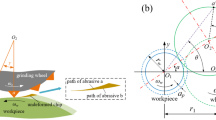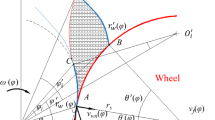Abstract
Grinding temperature field analysis is very significant to achieve controlled stress grinding and controlled grinding of affected layer depth. Heat source profile is an important basis for the grinding temperature field analysis. The heat source on the finished surface is more convenient than the heat source on the contact surface to perform grinding temperature field analysis both analytically and numerically. At present, the heat source profile on the finished surface was modeled to be rectangular, right triangular, triangular, or other shapes. However, all the modeled heat source profiles are not universally applicable under different grinding conditions. Therefore, the heat source profile on the finished surface under different grinding conditions needs to be further investigated. In this research, the inverse heat transfer analysis was performed to investigate the heat source profile on the finished surface under different grinding conditions. The investigation showed that the heat source profile on the finished surface is nearly right triangular in conventional shallow grinding, is triangular in creep feed grinding, and is close to be parabolic in HEDG (high efficiency deep grinding). Based on the investigation, the heat source profile on the finished surface was modeled as simple shapes to accommodate different grinding conditions. It was modeled to be right triangular in conventional shallow grinding and in creep feed grinding, and was modeled to be parabolic in HEDG. Error analyses of the predicted grinding temperatures obtained from the modeled heat source profiles were performed. The results showed that the modeled right triangular heat source profile is applicable in conventional shallow grinding and in creep feed grinding. The modeled parabolic heat source profile is applicable to most of the grinding parameters employed in HEDG. The modeled heat source profiles can conveniently serve as useful tools for grinding temperature field analysis in engineering.
Similar content being viewed by others
References
Malkin S, Guo C (2007) Thermal analysis of grinding. CIRP Ann Manuf Technol 56(2):760–782
Jaeger JC (1942) Moving sources of heat and the temperature of sliding contacts. J and Proc Roy Soc New South Wales 76:203–224
Rowe WB (2001a) Thermal analysis of high efficiency deep grinding. Int J Mach Tools Manuf 41(1):1–19
Rowe WB (2001b) Temperature case studies in grinding including an inclined heat source model. P I Mech Eng B-J Eng 215(4):473–491
Rowe WB, Jin T (2001) Temperatures in high efficiency deep grinding (HEDG). CIRP Ann Manuf Technol 50(1):205–208
Anderson D, Warkentin A, Bauer R (2008) Comparison of numerically and analytically predicted contact temperatures in shallow and deep dry grinding with infrared measurements. Int J Mach Tools Manuf 48(3):320–328
Doman DA, Warkentin A, Bauer R (2009) Finite element modeling approaches in grinding. Int J Mach Tools Manuf 49(2):109–116
Kohli S, Guo C, Malkin S (1995) Energy partition to the workpiece for grinding with aluminum oxide and CBN abrasive wheels. ASME J Eng Ind 117:160–168
Kim NK, Guo C, Malkon S (1997) Heat flux distribution and energy partition in creep-feed grinding. CIRP Ann-Manuf Techn 46(1):227–232
Guo C, Wu Y, Varghese V, Malkin S (1999) Temperatures and energy partition for grinding with vitrified CBN wheels. CIRP Ann Manuf Technol 48(1):247–250
Zarudi I, Zhang LC (2002) A revisit to some wheel-workpiece interaction problems in surface grinding. Int J Mach Tools Manuf 42(8):905–913
Kim HJ, Kim NK, Kwak JS (2006) Heat flux distribution model by sequential algorithm of inverse heat transfer for determining workpiece temperature in creep feed grinding. Int J Mach Tool Manu 46(15):2086–2093
Rowe WB, Black SCE, Mills B, Qi HS, Morgan MN (1995) Experimental investigation of heat transfer in grinding. CIRP Ann Manuf Technol 44(1):329–332
Jin T, Stephenson DJ (2006) Heat flux distributions and convective heat transfer in deep grinding. Int J Mach Tools Manuf 46(14):1862–1868
Brosse A, Naisson P, Hamdi H, Bergheau JM (2008) Temperature measurement and heat flux characterization in grinding using thermography. J Mater Process Tech 201(1):590–595
Li B, Zhu D, Pang J, Yang J (2011) Quadratic curve heat flux distribution model in the grinding zone. Int J Adv Manuf Technol 54(9–12):931–940
Tian Y, Shirinzadeh B, Zhang D, Chetwynd D (2009) Effects of the heat source profiles on the thermal distribution for ultraprecision grinding. Precis Eng 33(4):447–458
Shah SM, Nelias D, Zain-ul-abdein M, Coret M (2012) Numerical simulation of grinding induced phase transformation and residual stresses in AISI-52100 steel. Finite Elem Anal Des 61:1–11
Wang D, Ge P, Bi W, Zheng C (2015) Heat source profile in grinding zone. J Xi'an Jiaotong Univ 49(8):116–121
Wang D, Ge P, Bi W, Jiang J (2014) Grain trajectory and grain workpiece contact analyses for modeling of grinding force and energy partition. Int J Adv Manuf Technol 70(9):2111–2123
Guo C, Malkin S (1996a) Inverse heat transfer analysis of grinding, part 1: methods. J Eng Ind 118(1):137–142
Guo C, Malkin S (1996b) Inverse heat transfer analysis of grinding, part 2: applications. J Eng Ind 118(1):143–149
de Carvalho RN, Orlande HRB, Özisik MN (2000) Estimation of the boundary heat flux in grinding via the conjugate gradient method. Heat Transfer Eng 21(4):71–82
Author information
Authors and Affiliations
Corresponding author
Rights and permissions
About this article
Cite this article
Wang, D., Ge, P., Sun, S. et al. Investigation on the heat source profile on the finished surface in grinding based on the inverse heat transfer analysis. Int J Adv Manuf Technol 92, 1201–1216 (2017). https://doi.org/10.1007/s00170-017-0189-1
Received:
Accepted:
Published:
Issue Date:
DOI: https://doi.org/10.1007/s00170-017-0189-1




